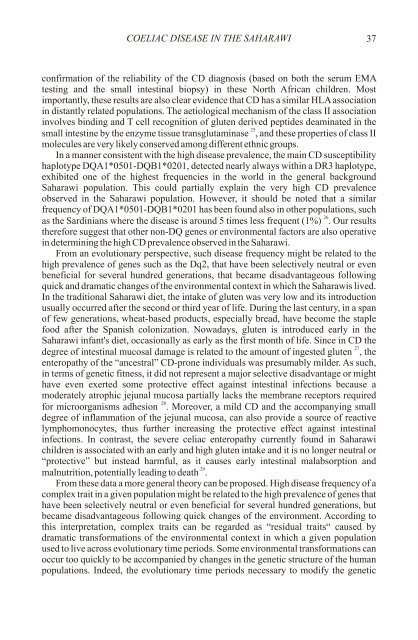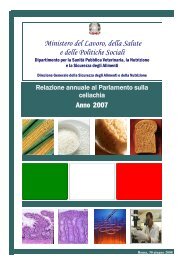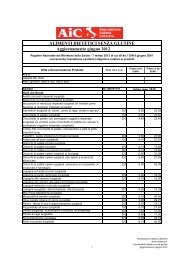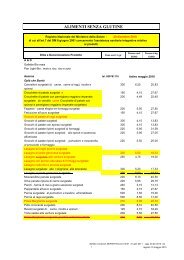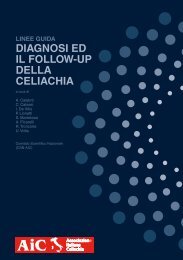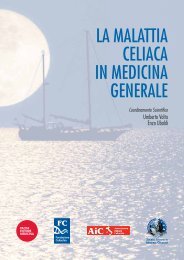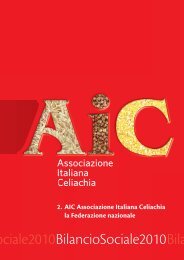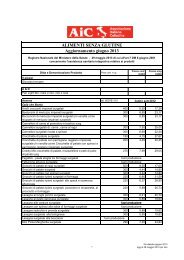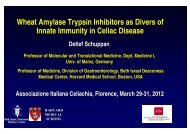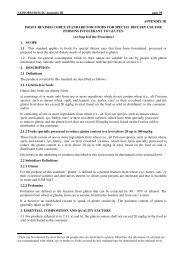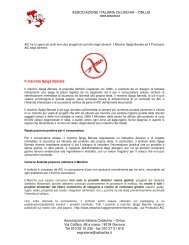primary prevention of coeliac disease - Associazione Italiana ...
primary prevention of coeliac disease - Associazione Italiana ...
primary prevention of coeliac disease - Associazione Italiana ...
You also want an ePaper? Increase the reach of your titles
YUMPU automatically turns print PDFs into web optimized ePapers that Google loves.
COELIAC DISEASE IN THE SAHARAWI<br />
37<br />
confirmation <strong>of</strong> the reliability <strong>of</strong> the CD diagnosis (based on both the serum EMA<br />
testing and the small intestinal biopsy) in these North African children. Most<br />
importantly, these results are also clear evidence that CD has a similar HLA association<br />
in distantly related populations. The aetiological mechanism <strong>of</strong> the class II association<br />
involves binding and T cell recognition <strong>of</strong> gluten derived peptides deaminated in the<br />
25<br />
small intestine by the enzyme tissue transglutaminase , and these properties <strong>of</strong> class II<br />
molecules are very likely conserved among different ethnic groups.<br />
In a manner consistent with the high <strong>disease</strong> prevalence, the main CD susceptibility<br />
haplotype DQA1*0501-DQB1*0201, detected nearly always within a DR3 haplotype,<br />
exhibited one <strong>of</strong> the highest frequencies in the world in the general background<br />
Saharawi population. This could partially explain the very high CD prevalence<br />
observed in the Saharawi population. However, it should be noted that a similar<br />
frequency <strong>of</strong> DQA1*0501-DQB1*0201 has been found also in other populations, such<br />
26<br />
as the Sardinians where the <strong>disease</strong> is around 5 times less frequent (1%) . Our results<br />
therefore suggest that other non-DQ genes or environmental factors are also operative<br />
in determining the high CD prevalence observed in the Saharawi.<br />
From an evolutionary perspective, such <strong>disease</strong> frequency might be related to the<br />
high prevalence <strong>of</strong> genes such as the Dq2, that have been selectively neutral or even<br />
beneficial for several hundred generations, that became disadvantageous following<br />
quick and dramatic changes <strong>of</strong> the environmental context in which the Saharawis lived.<br />
In the traditional Saharawi diet, the intake <strong>of</strong> gluten was very low and its introduction<br />
usually occurred after the second or third year <strong>of</strong> life. During the last century, in a span<br />
<strong>of</strong> few generations, wheat-based products, especially bread, have become the staple<br />
food after the Spanish colonization. Nowadays, gluten is introduced early in the<br />
Saharawi infant's diet, occasionally as early as the first month <strong>of</strong> life. Since in CD the<br />
27<br />
degree <strong>of</strong> intestinal mucosal damage is related to the amount <strong>of</strong> ingested gluten , the<br />
enteropathy <strong>of</strong> the “ancestral” CD-prone individuals was presumably milder. As such,<br />
in terms <strong>of</strong> genetic fitness, it did not represent a major selective disadvantage or might<br />
have even exerted some protective effect against intestinal infections because a<br />
moderately atrophic jejunal mucosa partially lacks the membrane receptors required<br />
28<br />
for microorganisms adhesion . Moreover, a mild CD and the accompanying small<br />
degree <strong>of</strong> inflammation <strong>of</strong> the jejunal mucosa, can also provide a source <strong>of</strong> reactive<br />
lymphomonocytes, thus further increasing the protective effect against intestinal<br />
infections. In contrast, the severe celiac enteropathy currently found in Saharawi<br />
children is associated with an early and high gluten intake and it is no longer neutral or<br />
“protective” but instead harmful, as it causes early intestinal malabsorption and<br />
29<br />
malnutrition, potentially leading to death .<br />
From these data a more general theory can be proposed. High <strong>disease</strong> frequency <strong>of</strong> a<br />
complex trait in a given population might be related to the high prevalence <strong>of</strong> genes that<br />
have been selectively neutral or even beneficial for several hundred generations, but<br />
became disadvantageous following quick changes <strong>of</strong> the environment. According to<br />
this interpretation, complex traits can be regarded as “residual traits“ caused by<br />
dramatic transformations <strong>of</strong> the environmental context in which a given population<br />
used to live across evolutionary time periods. Some environmental transformations can<br />
occur too quickly to be accompanied by changes in the genetic structure <strong>of</strong> the human<br />
populations. Indeed, the evolutionary time periods necessary to modify the genetic


